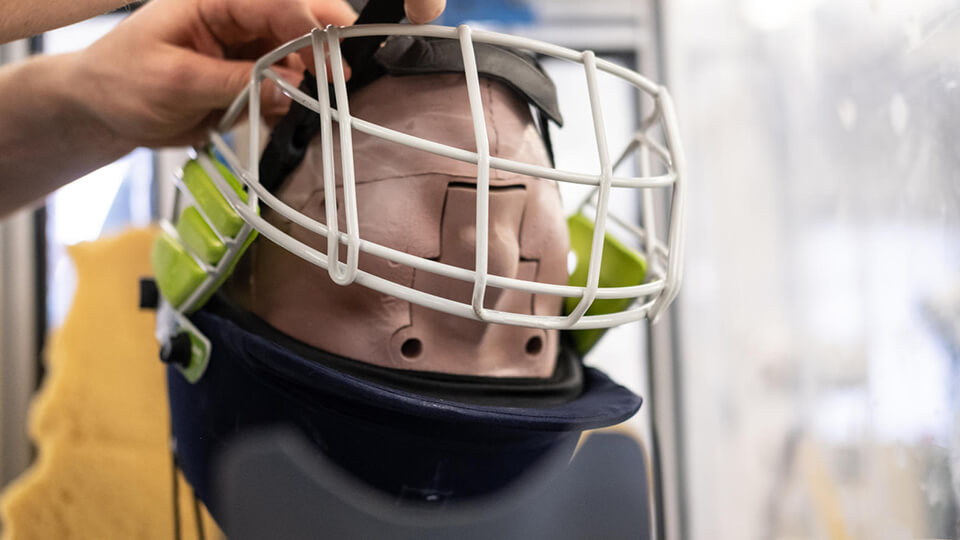Safety in cricket and beyond
Start making an impact - Professor Andy Harland explains how research from Loughborough's Sports Technology Institute is having an impact on the safety standards of sports around the world.
As the best university in the world for sports related subjects (QS World Rankings 2021), our academics and researchers have been setting the benchmark for many years. Their research has a significant influence around the world, and as a student on one of our courses, you could have the opportunity to be involved.
Professor Andy Harland explains the impact the research undertaken at the Sports Technology Institute has had on the safety of cricket helmets.
Cricket is one of the most popular sports in the world, and to keep pace with the demands of modern entertainment-based sport, it has undergone a change with the introduction of formats such as twenty20 cricket. The faster paced formats have meant that the sorts of shots that players are attempting are becoming riskier, and there was a period when the number of injuries to the head was on the rise. In addition, on a few occasions, players were suffering injuries, despite wearing a helmet, particularly in the facial region.

The research
At the time, the safety standard for cricket helmets had not changed for some time. The England and Wales Cricket Board reached out to Loughborough’s Sports Technology Institute, to help understand how new tests could be developed and incorporated into standards to improve player safety.
We carried out a lot of lab-based reconstructions, which included video and technical analysis to understand why the grilles and helmets were failing. We found that there were a number of facial injuries caused by either the ball penetrating through the helmet, or actually deforming the grille back onto the face.
We knew we needed to do something about it and our research was shared with all the leading manufacturers and informed a revision to the British Standard, to ensure the safety of batters. Since the revised British Standard has been published, there has not been any reports of career-threatening facial injury to someone wearing a helmet. To see our research have such a positive impact is absolutely fantastic.
Neck guards

In 2014, Australian batsman, Phillip Hughes was hit on the neck whilst playing cricket in Sydney for South Australia. Sadly, he passed away from catastrophic damage to his vertebral artery, and it had a significant impact on the world of cricket. During the coroner’s inquest, it was very clear that whilst helmet technology had moved on, there were still areas in which it needed to improve, to assess the quality of the neck guards that had been developed.
We noticed that after the tragic accident of Phillip Hughes, a number of players were wearing neck protectors, but these were not subject to any standard testing. We teamed up once again with the England and Wales Cricket Board and this time we were joined by Cricket Australia and a number of other partners and manufacturers, to ensure that appropriate tests were available which were included in a 2019 revision of the British Standard.
Moving forwards
The aim of our research is to better understand the mechanisms by which injuries to the head and neck occur, and inform manufacturers, administrators and standards authorities so that safety products can be as effective as possible. At times the injuries that are prevented might be fairly minor, but on rare occasions, they can be much more serious which is where the value of the research is really borne out. The findings of the research in cricket have relevance to other sports as well.
The research we carried out revealed some insights that may be relevant to some other sports. We started to and are continuing to investigate different types of collisions that may be present in other sports. Not only will this allow us to share good practice across sport, but it will also allow us to identify key areas of difference, where a different approach might be required to prevent injuries in the first place, or to diagnose, or treat injury in sport.
We are working with medical partners across all of these sports, including hockey where there are comparable issues, with similar sized balls, speeds and where both sports use a wooden stick or bat, with the potential for similar injuries. Our aim is to continue to make sport a safer place, and whilst we have made vast steps so far, we know that this goes beyond facial and head injuries, but actually minimising all forms of injury.

The impact
To date, the recommendations of Andy Harland and the team at Loughborough’s Sports Technology Institute have been accepted in two British Standards. The research has had a significant impact on safety in the game around the world, eliminating serious and life-threatening facial injuries from cricketers wearing helmets, allowing players, and spectators, to enjoy the drama of aggressive cricket with reduced risk of injury.
Since 2017, players in 104 countries across five continents benefit from conforming helmets. The International Cricket Council now maintains a list of manufacturers and helmet models certified to the new standards and there has been a ripple effect across other sports governing bodies, including the International Hockey Federation who have adopted a new research-based approach to health and safety.

Apply now
Find out everything you need to know about applying to study at university and start your Loughborough journey!